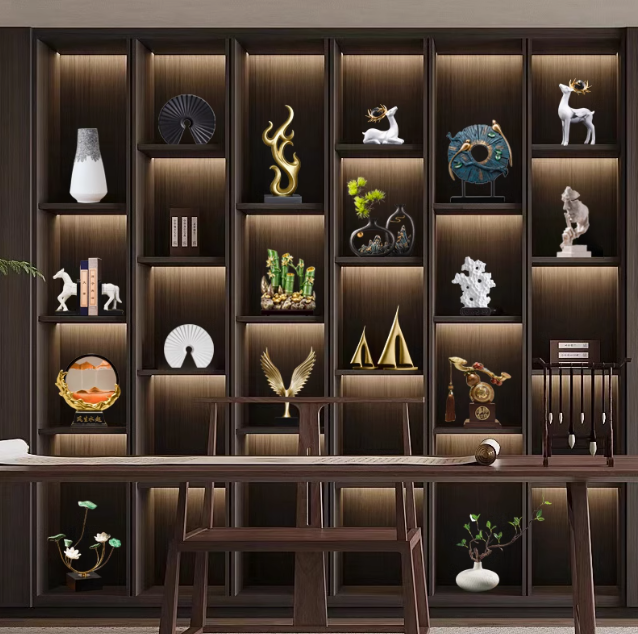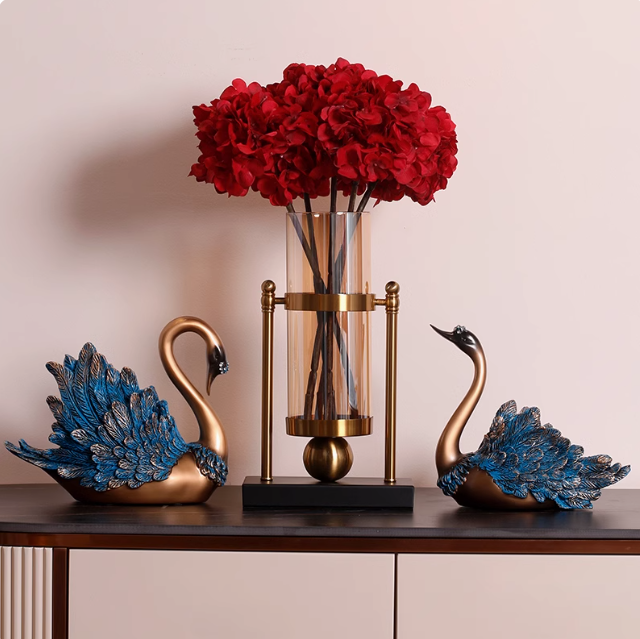미니멀리즘 디자인으로 아름다운 공간 만들기
예술 홈 장식 수년에 걸쳐 상당히 진화해 왔으며, 최소주의는 차분하고 기능적인 생활 공간을 창출하는 강력한 접근 방식으로 떠올랐습니다. 이 성의 있는 스타일의 집 장식은 적으면 많다는 원칙을 강조함으로써, 집 주인들이 세련되고 평온한 느낌을 주는 환경을 조성할 수 있게 해줍니다. 우리가 불필요한 요소를 제거하면, 우리에게 진정으로 중요한 것이 남게 되는데, 바로 우리의 웰빙을 증진시키고 우리 본질적인 성향을 반영하는 공간입니다.
미니멀리즘 홈 인테리어의 세계로 들어가면서, 이러한 디자인 철학이 어떻게 모든 생활 공간을 차분함과 목적감이 있는 안식처로 바꿔줄 수 있는지 알아보게 될 것입니다. 처음으로 아파트를 꾸미는 중이든 기존 주택의 분위기를 새롭게 하고자 하든, 미니멀리즘 원칙을 이해하는 것은 공간에 관한 현명한 결정을 내리는 데 도움이 됩니다.
미니멀리즘 디자인의 기본 원칙
여백의 힘
미니멀리즘 홈 인테리어에서 여백은 비어 있는 것이 아니라 의미가 있습니다. 이 근본적인 개념은 가구, 액세서리 및 시각적 혼잡물 없이 일부 영역을 비워두는 것을 포함합니다. 여백을 적극적으로 활용함으로써 눈이 쉴 수 있고 마음이 평화를 찾을 수 있는 여유를 만들 수 있습니다. 집의 구조를 하나의 캔버스로 생각하고, 여기에 추가하는 각 요소가 특정 목적을 달성하거나 진정한 기쁨을 줄 수 있어야 합니다.
음영 공간을 전략적으로 사용하면 선택한 장식 요소를 더욱 돋보이게 할 수 있습니다. 깔끔한 벽면에 단 하나의 인상적인 예술 작품을 배치할 경우, 여러 개의 다른 요소들에 둘러싸여 있을 때보다 더 강한 인상을 줍니다. 이러한 집 꾸미기 접근 방식은 각각의 소품이 방해받지 않고 자체적으로 이야기를 전달할 수 있도록 해줍니다.
양 보다 질
집을 최소한의 소품으로 꾸미는 미니멀리즘 접근법은 여러 개의 저품질 소품으로 공간을 채우는 대신, 적은 수의 고품질 제품에 투자하는 것을 중시합니다. 이 원칙은 가구뿐 아니라 조명기구에서 장식 소품에 이르기까지 인테리어의 모든 측면으로 확장됩니다. 소품을 선택할 때는 내구성, 기능성, 그리고 시간이 지나도 변하지 않는 매력을 고려해야 합니다.
가정의 각 아이템은 실용성 또는 아름다움, 가능하면 둘 다를 통해 그 자리에 존재할 만한 가치를 입증해야 합니다. 이는 수년간 사용할 수 있는 잘 만들어진 소파를 선택하거나 자신의 미적 비전을 완벽하게 표현하는 대표적인 가구를 고르는 것을 의미할 수 있습니다. 목표는 모든 요소가 목적을 가지고 기능하며 전반적인 조화에 기여하는 공간을 만드는 것입니다.
미니멀리스트 공간에서의 색상 이론
단색의 매력
미니멀리스트 홈 디자인의 핵심은 종종 신중하게 선별된 컬러 팔레트에 있습니다. 단일 색상을 중심으로 다양한 음영을 활용하는 단색 구성은 일관성과 평온함을 연출합니다. 따뜻한 흰색이나 부드러운 회색 같은 중성 색조를 기본으로 삼고, 동일한 색계열의 서로 다른 색조와 질감을 겹쳐 깊이와 흥미를 더하되, 미니멀리스트적인 미학을 해치지 않도록 합니다.
제한된 색상 팔레트를 사용한다고 해서 공간이 지루하게 느껴져야 하는 것은 아닙니다. 핵심은 색상의 조화를 유지하면서 시각적 흥미를 더해주는 다양한 질감과 소재를 활용하는 것입니다. 예를 들어, 흰색 계열로 꾸며진 방에는 매트한 벽면, 광택 있는 세라믹 소품, 부드러운 텍스타일 등을 포함시켜 색상 대신 질감을 통해 다양성을 창출할 수 있습니다.
전략적인 컬러 악센트
미니멀리즘은 종종 중성 색조를 선호하지만, 신중하게 사용된 색상은 인테리어 디자인을 더욱 풍부하게 만들어 줄 수 있습니다. 핵심은 한두 가지 악센트 색상을 선택하여 공간 곳곳에 절제 있게 배치하는 것입니다. 이러한 색상 포인트는 예술 작품, 쿠션, 또는 단 하나의 가구 조각에 나타나며, 시선을 유도하는 초점 역할을 합니다.
액센트 색상을 선택할 때는 감정에 미치는 영향과 기본 색상 조합과의 조화를 모두 고려하세요. 따뜻한 톤의 자연색은 시원한 회색 공간에 따뜻함을 더해줄 수 있으며, 은은한 파스텔톤은 단조로운 흰색 방을 부드럽게 만들어 줄 수 있습니다. 미니멀리스트 디자인에서는 액센트 색상 역시 전체적인 분위기와 의도적이고 조화롭게 어울려야 한다는 점을 기억하세요.

실용적인 수납 솔루션
숨겨진 수납 시스템
미니멀리스트 주택 인테리어에서는 정돈되지 않은 상태가 공간이 추구하는 평온함을 해칠 수 있으므로 효과적인 수납이 매우 중요합니다. 벽면과 매끄럽게 어우러지는 내장형 수납 솔루션은 깔끔한 라인을 유지하면서도 필수품을 충분히 보관할 수 있는 공간을 제공할 수 있습니다. 벽 색상과 동일하게 칠한 천장까지 이어지는 캐비닛을 설치하거나, 인테리어 소품 역할도 할 수 있는 수납 가구를 활용하는 것을 고려해보세요.
성공적인 숨겨진 수납의 핵심은 철저한 정리에 있습니다. 서랍 칸막이, 상자 및 바구니를 구비하여 물건들을 정돈하고 쉽게 꺼낼 수 있도록 하세요. 이러한 체계적인 수납 방식을 통해 보이는 표면뿐 아니라 실생활 공간 전반에 걸쳐 미니멀한 인테리어 스타일을 완성할 수 있습니다.
다기능 가구
미니멀리즘 홈 인테리어에서는 여러 용도로 활용할 수 있는 가구가 공간과 기능성을 극대화하는 데 도움이 됩니다. 내부 수납 공간이 있는 오토만형 커피 테이블, 책상이 내장된 머피 베드, 또는 업무용 워크스페이스로도 사용 가능한 식탁과 같은 제품을 찾아보세요. 이러한 다목적 가구들은 추가적인 가구 필요성을 줄여주면서도 미니멀리즘 디자인에 필수적인 깔끔하고 복잡하지 않은 외관을 유지시켜 줍니다.
다목적 가구를 선택할 때는 깔끔한 라인과 간단한 형태를 유지하는 제품을 우선적으로 고려하세요. 목적은 시각적인 복잡성을 만들지 않으면서 기능성을 더하는 것입니다. 각 가구가 사용 중일 때와 미사용 상태일 때 공간 내에서 어떻게 작용할지 고려해야 합니다.
미니멀리즘 디자인의 조명
자연광 최적화
자연 채광을 극대화하는 것은 미니멀리스트 공간에서 성공적인 인테리어 디자인의 핵심 요소입니다. 최대한 많은 햇빛이 들어오도록 창문 장식은 간단하고 가볍게 유지하세요. 프라이버시를 유지하면서 빛을 걸러주는 쉬어 커튼을 사용하거나, 사용하지 않을 때 완전히 숨길 수 있는 미니멀한 블라인드를 선택하는 것도 좋습니다.
거울 및 반사면 배치 또한 자연광을 증폭시켜 공간을 더 넓고 개방감 있게 느껴지게 하는 데 도움을 줄 수 있습니다. 창문 바로 앞에 거울을 전략적으로 배치하면 실내 자연광의 양을 두 배로 늘릴 수 있을 뿐 아니라 흥미로운 시각적 효과를 창출할 수 있습니다.
인공 조명 솔루션
자연 채광이 충분하지 않을 때는 인공 조명이 기능적일 뿐만 아니라 미적으로도 매력적이어야 합니다. 미니멀리스트 스타일의 집 꾸미기에서는 조명 장치가 종종 전체 디자인을 보완하는 조각적인 요소로 사용됩니다. 다양한 활동에 충분한 조명을 제공하면서도 미니멀리즘 원칙과 일치하는 단순하고 기하학적인 형태와 깔끔한 선을 선택하세요.
주변 조명, 작업용 조명, 액센트 조명을 계층적으로 활용하여 유연성과 시각적 흥미를 만들어내세요. 천장의 깔끔한 라인을 유지하기 위해 리세스드 조명을 고려하고, 펜던트 조명이나 플로어 램프를 신중하게 선택해 포인트를 더할 수 있습니다.
자주 묻는 질문
내가 소유한 모든 것을 버리지 않고 어떻게 미니멀리스트 스타일의 집 꾸미기로 전환할 수 있을까요?
한 번에 한 방씩 정리하면서 서서히 시작하세요. 먼저 쓸모가 없거나 기쁨을 주지 않는 물건들을 제거하는 데 집중하세요. 그런 다음 적절한 수납 솔루션을 사용해 남은 것들을 정리하세요. 점차 적은 양의 물건에도 익숙해지면, 미니멀리즘 원칙에 더 부합하는 고품질의 소수 아이템으로 여러 개의 물건을 대체함으로써 공간을 더욱 다듬을 수 있습니다.
미니멀한 홈 인테리어에 가장 적합한 색상은 무엇인가요?
미니멀한 공간은 흰색, 베이지색, 회색과 같은 중성 색조를 자주 사용하지만, 이러한 선택지로만 제한할 필요는 없습니다. 핵심은 2~3가지 주요 색상을 포함하는 일관된 색조 팔레트를 선택하는 것입니다. 중성 색조의 기본 배경에서 시작하여 공간 전체에 걸쳐 일관되게 사용할 수 있는 하나 또는 두 가지 보색을 더하세요.
미니멀한 공간에서 따뜻함과 개성을 어떻게 유지할 수 있나요?
신중하게 선택한 예술 작품, 사진 또는 의미 있는 소품을 통해 개인적인 감성을 더하세요. 자연 소재와 다양한 질감을 사용하여 따뜻함과 흥미를 더하세요. 미니멀리즘은 엄격하고 차가운 환경을 만드는 것이 아니라, 선택에 있어 의도적이고 공간 속 각 요소가 목적과 의미를 갖도록 하는 것임을 기억하세요.
